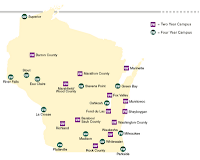How Bad Are Things in Wisconsin, Really?

When things look terrible in your neck of the woods, it's always useful to take a look around-- it helps to put things in perspective.
I've been hearing a lot about how Wisconsin has disinvested in higher education over the past several decades, leaving Madison with no choice but to jump ship to become its own public authority.
Today Tom Mortenson issued the latest issue of Postsecondary Education Opportunity, this one on "State Fiscal Support for Higher Education."
Here are a few key highlights:
(1) In FY 2011 Wisconsin ranks 23rd in state fiscal support for operating expenses of higher education per $1,000 of personal income. The state spends $6.72, compared to a national average of $6.30. Iowa, Minnesota, Illinois, Michigan, Virginia, Ohio all spend LESS.
(2) We rank 34th in the rate of change in state fiscal support over time (FY1980-FY2011). The national average is a decrease of 39.9% -- in Wisconsin we saw a decline of 45.2%. In contrast, Minnesota saw a 55.8% decline, Virginia a 53.6% decline, and Michigan a 45.3% decline. The decline we have experienced in the last 10 years was especially mild, compared to declines felt in other states (15.3% compared to 18.1% on average). Heck, Virginia saw a 38.2% decline in the last 10 years alone, and Michigan a 32.3% decline!
So, what's really going on? How can we juxtapose this with the rampant claims that the state support for UW-Madison (and UW System generally) has become a smaller and smaller share of our revenue over time? The key word in those claims is "share." Sure, we've had some declines in state support (while we should have had some increase to keep up with the increasing per-pupil costs of education)-- but the much larger change at UW-Madison is the significant growth in our federal funding and revenue from tuition and fees. Thus, as a percentage of Madison's total budget, the state's share is smaller. That's the figure being used to say that we (Madison) are no longer a public institution "anyway" -- and thus a public authority isn't a real change.
But that seems to twist the facts-- the state has continued to invest in Wisconsin higher education (and Madison in particular), albeit at a lower rate than before (other expenses like Medicare and prison are getting in the way), and since UW-Madison has not kept costs sufficiently under control it's turned to other sources to compensate. My guess? It would've done that anyway, to grow the research function of the university. Just look at our expenditures over the last ten years-- the ratio of money spent on teaching vs. research declined from 0.65 in 1999-2000 to 0.57 in 2004-2005, and now sits at .63. Put differently, we've seen a 56% increase in spending on research over the last decade, compared to a 51% increase in spending on instruction.
Facts are important-- let's stick to them. Wisconsin would be very wise to invest more in public higher education, since the economic and social returns are substantial. But it's not the case that Madison is at particular risk of a decline in instructional quality, a problem that COULD ONLY BE SOLVED by the New Badger Partnership.
In my opinion, the University of Wisconsin System needs to lead a hard conversation about the missions of its institutions, what they can and should receive public funding to achieve, and what priority must be given to cost-containment and instruction.

Comments
Post a Comment